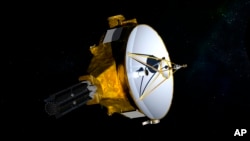Just 33 minutes into the New Year, NASA's New Horizons probe made space exploration history, flying by the most distant body ever visited by a spacecraft from earth.
The Johns Hopkins University Applied Physics Laboratory, which built and operates the spacecraft, said Tuesday it had "zipped past" the object known as 2014 MU69, or Ultima Thule.
About 10 hours later, Mission Operations Manager Alice Bowman said "We've just accomplished the most distant flyby," to enthusiastic applause from colleagues.
New Horizons, which is the size of a baby grand piano and part of an $800 million mission launched in 2006, collected data for four hours after the flyby.
Scientists said it will take almost two years for the probe to send back all the data it collected during its encounter with Ultima Thule.
Early blurry images showed and oblong shaped object nearly 35 kilometers long and more than 14 kilometers wide. More images and data were expected to begin arriving later Tuesday, giving scientists the first close look at a building block of the planets in our solar system.
"Everything we are going to learn about Ultima ... are going to teach us about the original formation conditions of objects in the solar system," said lead planetary scientist Alan Stern.
Mark Holdridge, who managed the probe's encounter with Pluto, said New Horizons will "continue to gather outbound science" as it travels away from our solar system.
In 2015, New Horizons flew by Pluto, then the farthest object visited by a spacecraft from Earth. Tuesday's encounter took place 1.6 billion kilometers past Pluto, some 6.5 billion kilometers from Earth.
Ultima Thule was discovered in June 2014 by NASA's Hubble Space Telescope, which was trying to find new targets in the path of New Horizons.






